注:本文为 “amplitude 与 magnitude” 相关文章合辑。
机翻,未校。
已对原文图片清晰度进行增强。
FFT amplitude or magnitude
FFT 振幅还是幅度
Can I use the word amplitude instead of magnitude when I describe FFT bins? I don’t see any similar word in my language.
在描述 FFT 频段时,我可以用“amplitude(振幅)”这个词代替“magnitude(幅度)”吗?我在自己的语言里找不到类似的词。
Deve edited Mar 21, 2013 at 10:05
I’ve always considered them to be somewhat related, but different:
我一直认为它们有所关联,但又有所不同:
Amplitude is the peak value of a sinusoid in the time domain.
振幅是时域中正弦波的峰值。
Magnitude is the absolute value of any value, as opposed to its phase.
幅度是任何值的绝对值,与相位相对。
With these meanings, you would not use amplitude for FFT bins, you would use magnitude, since you are describing a single value. The link would be that for a pure sinusoid, the signal amplitude would be the same as the magnitude of the appropriate FFT bin (“same as” depending on what scaling etc is used in the FFT implementation, but at the very least will be “proportional to”).
基于这些含义,描述 FFT 频段时不会用“amplitude(振幅)”,而会用“magnitude(幅度)”,因为描述的是单个值。其联系在于,对于纯正弦波,信号振幅与相应 FFT 频段的幅度相同(“相同”取决于 FFT 实现中使用的缩放等因素,但至少是“成比例”的)。
In saying all that, if you were to tell me about the amplitude of an FFT bin, I would know exactly what you were talking about.
话虽如此,如果有人跟我讲 FFT 频段的振幅,我也完全能明白所指内容。
lxop answered Mar 21, 2013 at 20:14
Even I had confusion differentiating between these two terms at the beginning, have a look at this explanation from one of the Award-winning DSP books.
一开始我也对这两个术语的区别感到困惑,看看这本获奖的数字信号处理(DSP)书籍中的解释吧。
SIGNAL AMPLITUDE, MAGNITUDE, POWER
Let’s define two important terms that we’ll be using throughout this book: amplitude and magnitude. It’s not surprising that, to the layman, these terms are typically used interchangeably. When we check our thesaurus, we find that they are synonymous. In engineering, however, they mean two different things, and we must keep that difference clear in our discussions.
The amplitude of a variable is the measure of how far, and in what direction, that variable differs from zero. Thus, signal amplitudes can be either positive or negative. The time-domain sequences in Figure 1-3 presented the sample value amplitudes of three different waveforms. Notice how some of the individual discrete amplitude values were positive and others were negative.
Amplitudes
振幅

Magnitudes
幅度
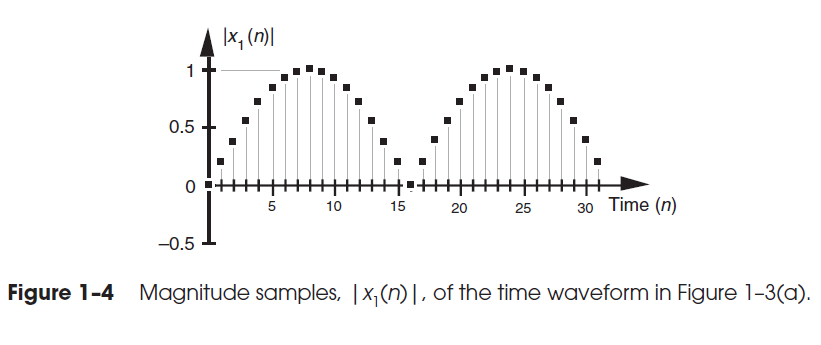
The magnitude of a variable, on the other hand, is the measure of how far, regardless of direction, its quantity differs from zero. So magnitudes are always positive values. Figure 1-4 illustrates how the magnitude of the x 1 ( n ) x_1 (n) x1(n) time sequence in Figure 1-3 (a) is equal to the amplitude, but with the sign always being positive for the magnitude.We use the modulus symbol ( ∣ ∣ \vert\vert ∣∣) to represent the magnitude of x 1 ( n ) x_1 (n) x1(n).Occasionally, in the literature of digital signal processing, we’ll find the term magnitude referred to as the absolute value.
When we examine signals in the frequency domain, we’ll often be interested in the power level of those signals.The power of a signal is proportional to its amplitude (or magnitude) squared. If we assume that the proportionality constant is one, we can express the power of a sequence in the time or frequency domains as
x pwr ( n ) = ∣ x ( n ) ∣ 2 , ( 1 − 8 ) x_{\text {pwr}}(n) = \vert x (n) \vert^2, \quad (1-8) xpwr(n)=∣x(n)∣2,(1−8)
orX pwr ( m ) = ∣ X ( m ) ∣ 2 . ( 1 − 8 ′ ) X_{\text {pwr}}(m) = \vert X (m) \vert^2. \quad (1-8') Xpwr(m)=∣X(m)∣2.(1−8′)
Sufiyan Ghori answered Mar 21, 2013 at 13:53
Just because one book defines it that way doesn’t mean it’s standard among engineers.
仅仅一本书这样定义,并不意味着这就是工程师们通用的标准。
– endolith Commented Mar 28, 2013 at 19:52
Which book is this from?
这出自哪本书?
– sourcenouveau Commented Mar 23, 2015 at 13:50
@M.Dudley // Not sure, but probably it’s from Oppenheim’s book I learnt.
@M.Dudley // 不确定,但可能是我学过的奥本海姆的书。
- Digital Signal Processing: Oppenheim, Alan V.: Trade Paperback: 9780132146357
<https://www.powells.com/book/digital-signal-processing-9780132146357>

– Youngjae Commented Sep 7, 2016 at 1:11
@M.Dudley I just happened to come across this post while reading this exact book. It’s from Chapter 1 (section 1.2) in “Understanding Digital Signal Processing” by Richard G. Lyons.
@M.Dudley 我刚好在读这本书时看到了这篇文章。它来自 Richard G. Lyons 所著的《理解数字信号处理》第 1 章(1.2 节)。

– tjwrona Commented Jun 29, 2019 at 17:30
Difference Between Magnitude and Amplitude
幅度与振幅的区别
Magnitude and amplitude are frequently used interchangeably to describe characteristics of numbers in common parlance. Both words are interchangeable, according to a thesaurus. Yet in engineering, they signify two distinct things, therefore it’s crucial to know the difference.
在日常用语中,“Magnitude(幅度)”和“Amplitude(振幅)”常被互换使用来描述数字的特征。根据同义词词典,这两个词可以互换。然而在工程领域,它们代表着两种截然不同的概念,因此了解它们的区别至关重要。
The maximum positive or negative value to which a variable deviates from its mean is referred to as its amplitude. It is just the farthest a vibration or oscillation may go from its stable location (zero level). Because of this, signal amplitudes can either be positive or negative.
振幅指的是变量偏离其平均值的最大正值或负值。它仅仅是振动或振荡可能偏离其稳定位置(零电平)的最远距离。正因如此,信号的振幅可以是正值,也可以是负值。
On the other hand, a variable’s magnitude is a measurement of how much its amount deviates from zero in any direction. As a result, magnitudes are always positive.
另一方面,变量的幅度是对其在任何方向上偏离零的程度的度量。所以,幅度总是正值。
What is Amplitude?
什么是振幅?
Amplitude refers to the maximum displacement of a wave from its equilibrium position. It is a measure of the strength or intensity of a wave. Amplitude is usually represented by the letter A and is expressed in units of distance. For instance, in a sound wave, the amplitude can be used to describe the loudness of the sound.
振幅是指波从其平衡位置的最大位移。它是衡量波的强度或烈度的指标。振幅通常用字母 A 表示,并以距离单位来度量。例如,在声波中,振幅可用来描述声音的响度。
What is Magnitude?
什么是幅度?
Magnitude refers to the distance or quantity of a variable, regardless of its direction. In physics, the distance and the direction between two points can be represented by a quantity known as a vector.
幅度是指变量的距离或数量,不考虑其方向。在物理学中,两点之间的距离和方向可以用一个称为向量的量来表示。
Magnitude is the length of the vector, while direction simply is a way from point A to point B. By contrast, quantities known as scalar quantities only have magnitude, so they can be described using just a real number. The magnitude of a scalar quantity is a scalar.
幅度是向量的长度,而方向仅仅是从 A 点到 B 点的路径。相比之下,被称为标量的量只有大小,因此可以仅用一个实数来描述。标量的幅度就是标量本身。
Magnitude refers to the size of an object, which determines whether one object is larger or smaller than the other object. If you talk about magnitude of some object, you simply refer to its size or scale. For example, the magnitude of a football is greater than that of a tennis ball or a golf ball for that matter. Magnitude is used to measure the extent of an earthquake or an explosion.
幅度还用于描述物体的大小,它决定了一个物体比另一个物体大还是小。当提及某个物体的幅度时,仅仅是指它的大小或规模。例如,足球的大小大于网球或高尔夫球。幅度还用于衡量地震或爆炸的强度。
Applications of Magnitude and Amplitude
幅度与振幅的应用
Magnitude and amplitude have various applications in different fields. In physics, magnitude is used to describe the strength or intensity of a physical quantity. For example, in electrostatics, the magnitude of the electric field strength is used to describe the force exerted on a charged particle.
幅度和振幅在不同领域有多种应用。在物理学中,幅度用于描述物理量的强度或大小。例如,在静电学中,电场强度的幅度用于描述施加在带电粒子上的力。
In contrast, amplitude is used to describe the intensity or strength of a wave. For instance, in the study of sound waves, the amplitude is used to describe the loudness of a sound. In electromagnetic waves, such as light waves, the amplitude can be used to describe the brightness of the light.
相比之下,振幅用于描述波的强度或大小。例如,在研究声波时,振幅用于描述声音的响度。在电磁波(如光波)中,振幅可用于描述光的亮度。
Moreover, amplitude is also used in the field of signal processing. In this field, amplitude is used to describe the strength of a signal. This information can be used to filter out noise from a signal or to amplify a weak signal.
此外,振幅在信号处理领域也有应用。在这个领域,振幅用于描述信号的强度。这些信息可用于滤除信号中的噪声或放大微弱信号。
Differences: Magnitude and Amplitude
幅度与振幅的差异
The main difference between magnitude and amplitude is that magnitude refers to the size or amount of a physical quantity, while amplitude refers to the strength or intensity of a wave. Magnitude is a scalar quantity that can be positive, negative, or zero, while amplitude is a vector quantity that has both magnitude and direction.
幅度和振幅的主要区别在于,幅度指的是物理量的大小或数量,而振幅指的是波的强度或大小。幅度是一个标量,可以是正值、负值或零,而振幅是一个矢量,既有大小又有方向。
Another difference between magnitude and amplitude is the way they are measured. Magnitude is measured using different units depending on the physical quantity being measured. For example, distance can be measured in meters, speed in meters per second, and force in Newtons. Amplitude, on the other hand, is measured in units of distance, such as meters, millimeters, or micrometers.
幅度和振幅的另一个区别在于它们的测量方式。幅度根据所测量的物理量使用不同的单位来度量。例如,距离可以用米来测量,速度用米每秒来测量,力用牛顿来测量。而振幅则以距离单位来测量,如米、毫米或微米。
The following table highlights the major differences between Amplitude and Magnitude −
下表突出了振幅和幅度之间的主要区别:
| Characteristics 特性 | Amplitude 振幅 | Magnitude 幅度 |
|---|---|---|
| Definition 定义 | The amplitude of a variable is the measure of deviation of that variable from its central position up to a positive or negative value. 变量的振幅是该变量从其中心位置偏差到正值或负值的度量。 It simply is the maximum displacement of a vibration or oscillation from its equilibrium position (zero level). 它只是振动或振荡从其平衡位置(零水平)的最大位移。 | Magnitude, on the other hand, refers to the distance or quantity of a variable, regardless of its direction. It refers to the size of an object, which determines whether one object is larger or smaller than the other object. 另一方面,幅度是指变量的距离或数量,无论其方向如何。它是指对象的大小,它决定了一个对象是大还是小于另一个对象。 Magnitude is a property more like area or volume, which doesn’t concern direction. 幅度是一个属性,更像是面积或体积,与方向无关。 |
| Property 属性 | Vector quantities have both magnitude and direction. Amplitude is a property that is unique to waves and oscillations. 向量既有大小又有方向。振幅是波和振荡所特有的特性。 Amplitude is one of the most important physical characteristics of a wave, other being the wavelength. They are both measures of distance. 振幅是波最重要的物理特性之一,其他特性是波长。它们都是距离的度量。 | Magnitude is the property of relative size or extent which generally concerns a vector quantity. 幅度是相对大小或程度的属性,通常与向量有关。 When we are talking about magnitude of some object, we simply refer to its size or scale. 当我们谈论某个物体的大小时,我们只是指它的大小或尺度。 Magnitude is a scalar quantity that possesses the size only, not direction. 幅度是一个标量,它只具有大小,而不具有方向。 |
| Example 例 | Amplitude simply measures the length and width of waves from the resting position, such as sound waves, as they vibrate or move. 振幅只是测量波(例如声波)从静止位置开始的长度和宽度,因为它们振动或移动。 The way radio waves or sound waves move back and forth and how much they move refers to its amplitude. 无线电波或声波来回移动的方式以及它们的移动程度是指其振幅。 | Magnitude is used to measure the extent or size of an explosion or an earthquake. Vector quantities in physics are expressed with both magnitude and direction. 震级用于测量爆炸或地震的程度或大小。物理学中的向量用大小和方向来表示。 For example, magnitude of movement is velocity. When we say 10m/s westward, it tells us both the magnitude of movement, which is 10 m/s, and the direction as well, which is westward. 例如,运动的大小就是速度。当我们说向西 10m/s 时,它告诉我们运动的大小,即 10 m/s,以及方向,即向西。 |
Conclusion
结论
In conclusion, magnitude and amplitude are two important concepts in the field of physics. While they are often used interchangeably, they actually refer to different aspects of a physical quantity or wave.
总之,幅度和振幅是物理学领域的两个重要概念。尽管它们常被互换使用,但实际上它们指的是物理量或波的不同方面。
Magnitude refers to the size or amount of a physical quantity, while amplitude refers to the strength or intensity of a wave.
幅度指的是物理量的大小或数量,而振幅指的是波的强度或大小。
Understanding the difference between these two concepts is important in various applications, such as electrostatics, sound waves, electromagnetic waves, and signal processing.
在静电学、声波、电磁波和信号处理等各种应用中,理解这两个概念的区别非常重要。
Magnitude vs Amplitude: Difference and Comparison
幅度与振幅:差异与比较
Magnitude and amplitude are the terms representing some factors of important factors of science, more precisely, different branches of physics. In engineering, the differences are clearly understood by the students.
幅度和振幅是代表科学中一些重要因素的术语,更确切地说,是物理学不同分支中的概念。在工程领域,学生们对它们的区别有着清晰的理解。
Magnitude and amplitude are different quantities and cannot be used interchangeably. So here are some basic differences between magnitude and amplitude.
幅度和振幅是不同的量,不能互换使用。以下是幅度和振幅之间的一些基本区别。
Key Takeaways
关键要点
-
Magnitude refers to the overall size or amount of something, while amplitude refers to the maximum displacement of a wave from its resting position.
幅度指的是某物的整体大小或数量,而振幅指的是波从其静止位置的最大位移。 -
Magnitude is a scalar quantity, while the amplitude is a vector quantity.
幅度是标量,而振幅是矢量。 -
Magnitude can describe various physical quantities such as force, energy, and velocity, while amplitude is used to describe properties of waves such as sound and light.
幅度可以描述各种物理量,如力、能量和速度,而振幅用于描述声音和光等波的特性。
Magnitude vs Amplitude
幅度与振幅的关系
The difference between magnitude and amplitude is that magnitude is used to define the real number or length of vectors in measurements of distances and other scalar quantities. Amplitude is mainly used in ac signals and oscillation theories. Amplitude is the measurement of the maximum vertical length of a wave on both positive and negative regions.
幅度(magnitude)和振幅(amplitude)的区别在于,幅度用于定义在距离测量和其他标量测量中向量的实数值或长度。振幅主要用于交流信号和振荡理论。振幅是对波在正负区域的最大垂直长度的测量。
Magnitude is a factor used to determine a quantity’s value. Magnitude is a quantity used to measure a number’s real part. This is a factor in determining vector quantities.
幅度是用于确定一个量的值的因素。幅度是用于测量一个数的实部的量。这是确定向量量的一个因素。
Vector quantity comprises both the magnitude and direction of a factor to be determined. It can be both positive and negative.
向量量包括要确定的一个因素的大小和方向。它可以是正值也可以是负值。
Amplitude is used to measure the vertical length of a sinusoidal wave. It also measures the maximum and minimum values for a periodically changing quantity.
振幅用于测量正弦波的垂直长度。它还测量周期性变化量的最大值和最小值。
Amplitude is a scalar quantity, which means that it has only magnitude and so does not have any directions. Amplitude is a factor mainly used in ac signals, oscillation, and communication theories.
振幅是一个标量,这意味着它只有大小,没有任何方向。振幅是主要用于交流信号、振荡和通信理论的一个因素。
Comparison Table
对比表
| Parameters of Comparison **比较参数 | Magnitude 幅度 | Amplitude 振幅 |
|---|---|---|
| Definition 定义 | It is the real number value of a quantity such as distance or displacement irrespective of direction. 它是一个量(如距离或位移)的实数值,与方向无关。 | It is the maximum vertical distance of a sinusoidal wave in both positive and negative. 它是正弦波在正负方向上的最大垂直距离。 |
| Properties of 属性 | *It is a property of vector quantity.*它是向量的一种属性。 | It is a property that is unique to sinusoidal waves and oscillation. 它是正弦波和振荡所特有的属性。 |
| Positive or negative 正负性 | It can be both positive and negative. 它可以是正值,也可以是负值。 | It is always positive. 它始终为正值。 |
| Used to measure 用于测量 | The real part of the value to a quantity. 一个量值的实部。 | The vertical length of a sinusoidal wave 正弦波的垂直长度。 |
| Scalar or vector 标量或向量 | It is itself a part of determining the scalar or vector quantities. 它本身是确定标量或向量的一部分。 | It is a scalar quantity. 它是一个标量。 |
What is Magnitude?
什么是幅度?
Magnitude is a factor used to determine a quantity’s value. Magnitude is a quantity used to measure a number’s real part. This is a factor in determining vector quantities.
幅度是用于确定一个量的值的因素。幅度是用于测量一个数的实部的量。这是确定向量量的一个因素。
Vector quantity comprises both the magnitude and direction of a factor to be determined. It can be both positive and negative.
向量量包括要确定的一个因素的大小和方向。它可以是正值也可以是负值。
Magnitude is a common property of all the secondary quantities in physics. The secondary quantities are divided into scalar and vector quantities. If the quantity is scalar, that means that it poses only magnitude and no direction.
幅度是物理学中所有派生量的一个共同属性。派生量分为标量和向量。如果这个量是标量,那就意味着它只有大小,没有方向。
If the quantity is a vector, then it has both magnitude and direction. Magnitude is the size or the value of the quantity.
如果这个量是向量,那么它既有大小又有方向。幅度就是这个量的大小或值。
The magnitude can be measured by
a
=
a
1
2
+
a
2
2
+
a
3
2
+
⋯
+
a
n
2
a = \sqrt{a_1^2 + a_2^2 + a_3^2 + \cdots + a_n^2}
a=a12+a22+a32+⋯+an2
幅度可以通过
a
=
a
1
2
+
a
2
2
+
a
3
2
+
⋯
+
a
n
2
a = \sqrt{a_1^2 + a_2^2 + a_3^2 + \cdots + a_n^2}
a=a12+a22+a32+⋯+an2 来测量。
Here ‘a’ is the total magnitude of the quantity.
这里的“a”是该量的总幅度。
For example, the distance and the displacement have the same meaning: the length between two points. But they differ as displacement is independent of direction, whereas distance has the factor of direction.
例如,距离和位移有相同的含义:两点之间的长度。但它们的区别在于,位移与方向无关,而距离包含方向因素。
Displacement only has magnitude. The magnitude of a factor can be both positive and negative. A negative normally indicates that the magnitude is in the opposite direction.
位移只有大小。一个因素的幅度可以是正值也可以是负值。负数通常表示幅度方向相反。
What is Amplitude?
什么是振幅?
Amplitude is used to measure the vertical length of a sinusoidal wave. It also measures the maximum and minimum values for a periodically changing quantity.
振幅用于测量正弦波的垂直长度。它还测量周期性变化量的最大值和最小值。
Amplitude is a scalar quantity, which means that it has only magnitude, and so does not have any directions. Amplitude is a factor mainly used in ac signals, oscillation, and communication theories.
振幅是一个标量,这意味着它只有大小,没有任何方向。振幅是主要用于交流信号、振荡和通信理论的一个因素。
In communication engineering, the amplitude is one of the main factors in the field of communication. The whole process of signal transfer and modern communication is based on the amplitude of a signal wave.
在通信工程中,振幅是通信领域的主要因素之一。信号传输和现代通信的整个过程都基于信号波的振幅。
The amplitude is varied accordingly to change the modulation of a wave and transmit the signal to the destination. There is a type of modulation known as amplitude modulation in which the amplitude is varied to change the modulation of a wave.
振幅会相应地变化,以改变波的调制并将信号传输到目的地。有一种调制方式称为幅度调制,其中通过改变振幅来改变波的调制。
If we consider
x
x
x as the periodically changing quantity with time
t
t
t, then
x
(
t
)
=
A
sin
(
2
π
f
t
)
x (t) = A\sin(2\pi ft)
x(t)=Asin(2πft)
如果我们将
x
x
x 视为随时间
t
t
t 周期性变化的量,那么
x
(
t
)
=
A
sin
(
2
π
f
t
)
x(t) = A\sin(2\pi ft)
x(t)=Asin(2πft)
Here,
A
A
A is the amplitude of a wave.
这里,
A
A
A 是波的振幅。
角频率(angular frequency;circular frequency)
Ref: 百度百科
角频率,也称圆频率,表示单位时间内变化的相角弧度值。角频率是描述物体振动快慢的物理量,与振动系统的固有属性有关,常用符号 ω \omega ω 表示。
在国际单位制中,角频率的单位是弧度/秒 (rad/s)。每个物体都有由它本身性质决定的与振幅无关的频率,叫做固有角频率。
在力学,光学,交变电路中,角频率都有着较为广泛的应用。
角频率数值上等于谐振动系统中旋转矢量的转动的角速度。频率( f f f )、角频率 ( ω \omega ω ) 和周期 ( T T T ) 的关系为 ω = 2 π f = 2 π / T \omega = 2\pi f = 2\pi/T ω=2πf=2π/T 。
The amplitude is independent of the factor direction. A wave’s amplitude can be measured on both positive and negative sides. But the magnitude of the amplitude of a wave is always a positive quantity. The amplitude of an ideal wave is the same on both sides of the number line.
振幅与方向因素无关。波的振幅可以在正负两侧测量。但波的振幅大小始终是正值。理想波在数轴两侧的振幅是相同的。
Main Differences Between Magnitude and Amplitude
幅度与振幅的主要区别
-
Magnitude is the real number value of a quantity, such as distance or displacement, irrespective of direction. On the other hand, the amplitude is the maximum vertical distance of a sinusoidal wave in both positive and negative.
幅度是一个量(如距离或位移)的实数值,与方向无关。而振幅是正弦波在正负方向上的最大垂直距离。 -
Magnitude is a property of vector quantity; it is the main factor in determining the vector quantity of any factor. Amplitude is a property that is unique to sinusoidal waves and oscillation.
幅度是向量量的一个属性,是确定任何因素向量量的主要因素。振幅是正弦波和振荡所特有的属性。 -
Magnitude can be both positive and negative, but the factor amplitude is always positive.
幅度可以是正值也可以是负值,但因子振幅始终是正值。 -
Magnitude is used to identify the real part of the value to a quantity, whereas amplitude is used to measure the vertical length of a wave.
幅度用于确定一个量值的实部,而振幅用于测量波的垂直长度。 -
Magnitude is itself a part of determining the scalar or vector quantities. On the other hand, the amplitude is a scalar quantity.
幅度本身是确定标量或向量量的一部分。而振幅是一个标量。
Difference Between Magnitude and Amplitude
幅度与振幅的区别
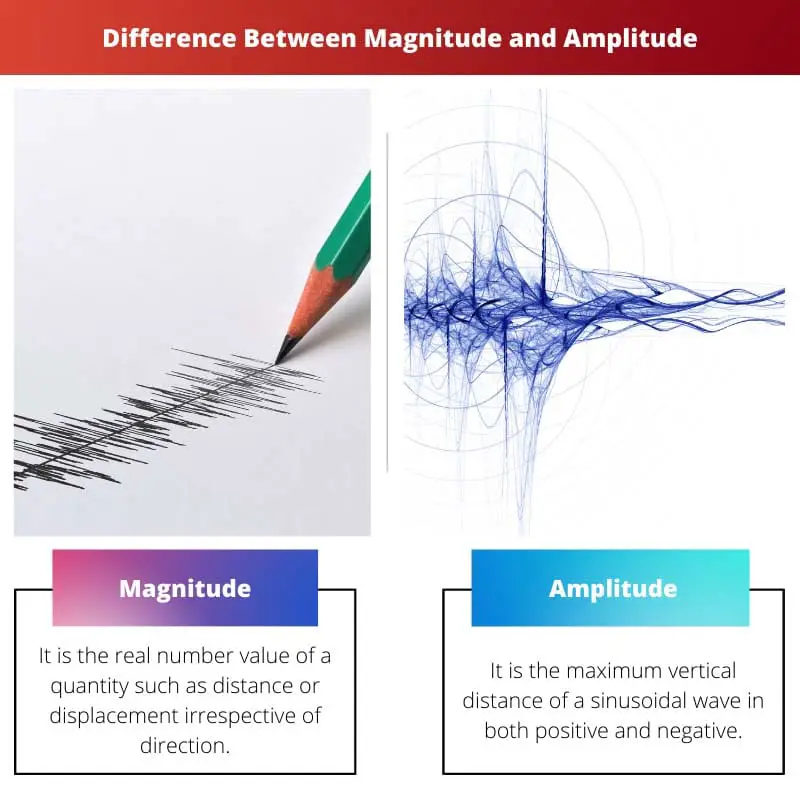
Magnitude
It is the real number value of a quantity such as distance or displacement irrespective of direction.
幅度:它是一个量(如距离或位移)的实数值,与方向无关。
Amplitude
It is the maximum vertical distance of a sinusoidal wave in both positive and negative.
振幅:它是正弦波在正负方向上的最大垂直距离。
References
-
An instrumental earthquake magnitude scale | Bulletin of the Seismological Society of America | GeoScienceWorld
<https://pubs.geoscienceworld.org/ssa/bssa/article/25/1/1/115102> -
A Brief Introduction to Modern Amplitude Methods | Journeys Through the Precision Frontier: Amplitudes for Colliders
<https://www.worldscientific.com/doi/abs/10.1142/9789814678766_0002>
Last Updated: 24 June, 2023
Piyush Yadav
Piyush Yadav has spent the past 25 years working as a physicist in the local community. He is a physicist passionate about making science more accessible to our readers.
Piyush Yadav 在当地社区从事物理研究工作已有 25 年。他是一位热衷于让科学更易于为读者所理解的物理学家。
via:
-
dft - FFT amplitude or magnitude - Signal Processing Stack Exchange
https://dsp.stackexchange.com/questions/8317/fft-amplitude-or-magnitude -
Difference Between Magnitude and Amplitude Vineet Nanda Updated on: 26 - Apr - 2023
https://www.tutorialspoint.com/difference-between-magnitude-and-amplitude -
Magnitude vs Amplitude: Difference and Comparison
https://askanydifference.com/difference-between-magnitude-and-amplitude/ -
Frequency Modulation vs Amplitude Modulation: Difference and Comparison
https://askanydifference.com/difference-between-frequency-modulation-and-amplitude-modulation/
 信号处理中幅度与振幅的区别
信号处理中幅度与振幅的区别





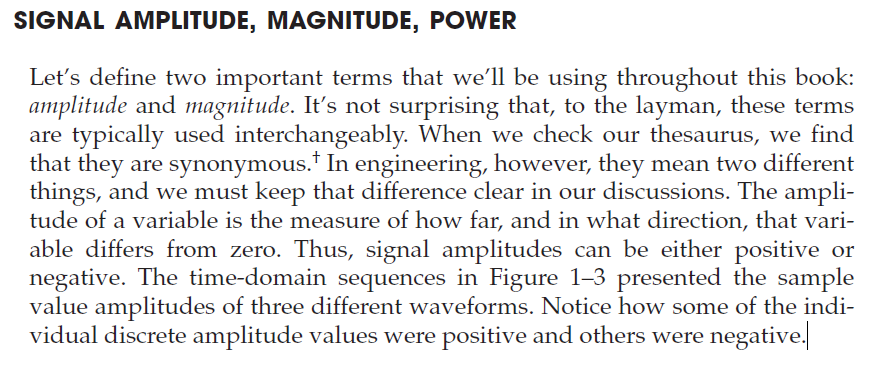
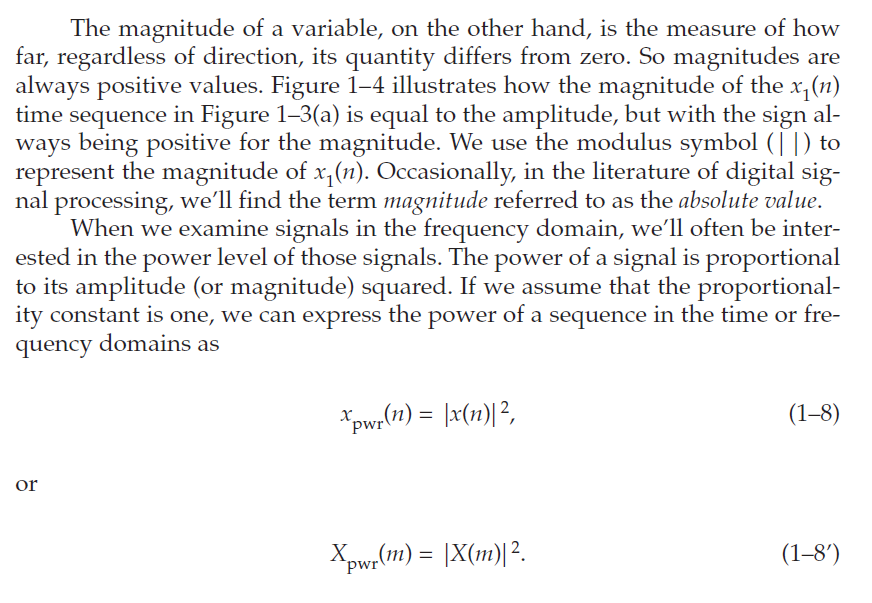
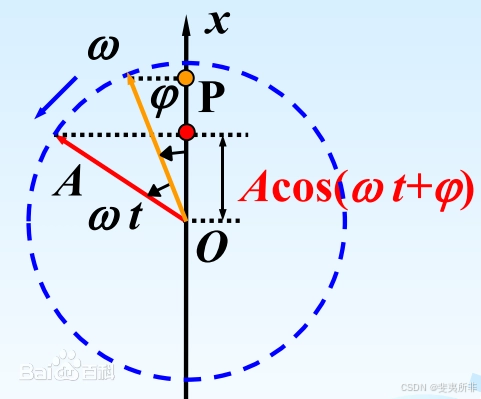
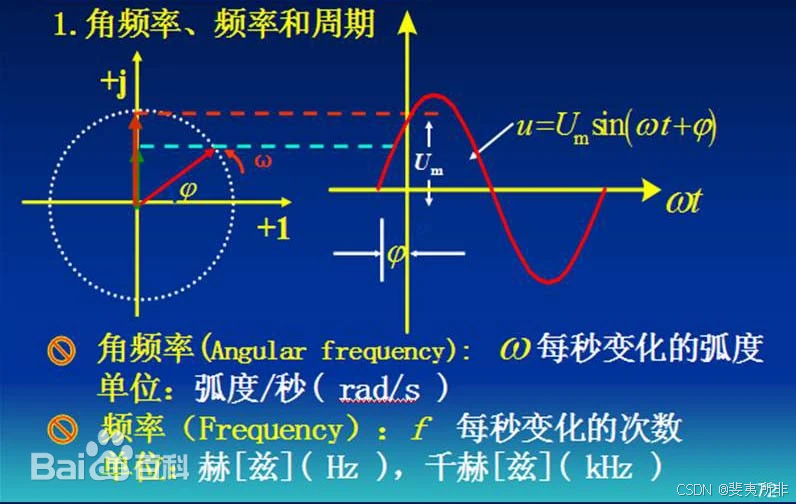
















 1010
1010

 被折叠的 条评论
为什么被折叠?
被折叠的 条评论
为什么被折叠?








